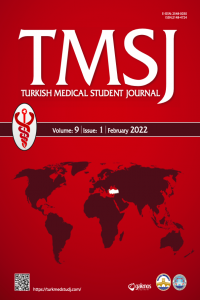ASSESSMENT OF THE AWARENESS AND OPINIONS OF TURKISH MEDICAL STUDENTS TOWARDS VIOLENCE AGAINST WOMEN: A QUESTIONNAIRE-BASED STUDY
ASSESSMENT OF THE AWARENESS AND OPINIONS OF TURKISH MEDICAL STUDENTS TOWARDS VIOLENCE AGAINST WOMEN: A QUESTIONNAIRE-BASED STUDY
violence, medical students, awareness,
___
- 1.European Union Agency for Fundamental Rights. Violence against women: an EU-wide survey: main results report. Luxembourg: Publications Office of the Eu- ropean Union; 2014.
- 2. United Nations. Declaration on the elimination of violence against women. New York: UN; 1993.
- 3. World Health Organization. Global and regional estimates of violence against women: prevalence and health effects of intimate partner violence and non-part- ner sexual violence. Geneva: WHO; 2013.
- 4. Altınay AG, Arat Y. Violence against women in Turkey: a nationwide survey. Is- tanbul: Punto; 2009.
- 5. Kaptanoglu Y, Cavlin I, Ergocmen AA et al. Research on domestic violence against women in Turkey. Main Report. Hacettepe University, Institute of Pop- ulation Studies: 2015.
- 6. Sharma P, Jamwal D, Mehta A et al. COVID 19- endangering women’s mental and reproductive health. JK Science 2020;22(3):106-9.
- 7. Adibelli D, Sümen A, Teskereci G. Domestic violence against women during the Covid-19 pandemic: Turkey sample. Health Care Women Int 2021;42(3):335-350.
- 8. World Health Organization. Femicide (serial online) 2012 (cited 2021 Apr). Available from: URL:https://apps.who.int/iris/bitstream/handle/10665/77421/ WHO_RHR_12.38_eng.pdf.
- 9. United Nations. Multilateral treaties deposited with the Secretary-General. (serial online) (cited 2021 Apr). Available from: URL:https://treaties.un.org/pages/par- ticipationstatus.aspx?clang=_en.
- 10. Gunes A. Legal implications of Turkey’s accessions to the Istanbul Convention by enacting and refining its laws on violence against women. Women & Criminal Justice 2019;31:(3)210-24.
- 11. Presidential Decision. Official Gazette of the Republic of Turkey (serial online) 2021 Mar 20: 31429. Available from: URL:https://www.resmigazete.gov.tr/eskil- er/2021/03/20210320-49.pdf.
- 12. Ramsay J, Rutterford C, Gregory A et al. Domestic violence: knowledge, attitudes, and clinical practice of selected UK primary healthcare clinicians. Br J Gen Pract 2012;62:647-55.
- 13. Salaçin S. Sağlık çalışanlarının kadına yönelik şiddetin önlenmesinde üstlen- ebilecekleri roller. Toplumsal Cinsiyet, Sağlık ve Kadın (serial online) 2003: (7 screens). Available from: URL:http://www.huksam.hacettepe.edu.tr/Turkce/Say- faDosya/saglik_calisanlarinin_kadina_yonelik.pdf.
- 14. Manuel B, Roelens K, Tiago A et al. Medical curricula on intimate partner vio- lence in Mozambique. Acta Med Port 2020;33(1):22-30.
- 15. Koschorke A, Tilzey A, Welch J. Should medical students be taught about rape? A survey of UK medical schools. BJOG 2007;114(2):224-5.
- 16. Kennedy KM, Vellinga A, Bonner N et al. How teaching on the care of the victim of sexual violence alters undergraduate medical students’ awareness of the key issues involved in patient care and their attitudes to such patients. J Forensic Leg Med 2013;20(6):582-7.
- 17. World Health Organization. Violence against women. (serial online) (cited 2021 Apr). Available from: URL:https://www.who.int/news-room/fact-sheets/detail/ violence-against-women.
- 18. Ernst AA, Houry D, Nick TG et al. Domestic violence: incidence and awareness in a first-year medical school class. Acad Emerg Med 1998;5(1):64-8.
- 19. Williams L, Forster G, Petrak J. Rape attitudes amongst British medical students. Med Educ 1999;33(1):24-7.
- 20. Anderson I, Quinn A. Gender differences in medical students' attitudes towards male and female rape victims. Psychol Health Med 2009;14(1):105-10.
- 21. Potter LC, Feder G. Domestic violence teaching in UK medical schools: a cross-sectional study. Clin Teach 2018;15(5):382-6.
- 22. Çalıkoglu EO, Aras A, Hamza M et al. Sexism, attitudes, and behaviors towards violence against women in medical emergency services workers in Erzurum, Tur- key. Glob Health Action 2018;11(1):1524541.
- 23. Hamzaoglu N, Türk B. Prevalence of physical and verbal violence against health care workers in Turkey. Int J Health Serv 2019;49(4):844-61.
- 24. Demirci Ş, Uğurluoğlu Ö. An evaluation of verbal, physical, and sexual violence against healthcare workers in Ankara, Turkey. J Forensic Nurs 2020;16(4):33-41.
- 25. Glenn AL, Raine A. The neurobiology of psychopathy. Psychiatr Clin N Am 2008;31:463-75.
- 26. Nielsen DA, Goldman D, Virkkunen M et al. Suicidality and 5-hydroxyin- doleacetic acid concentration associated with a tryptophan polymorphism. Arch Gen Psychiatry 1994;51(1):34-8.
- ISSN: 2148-4724
- Başlangıç: 2014
- Yayıncı: Trakya Üniversitesi
Fatih Erkan AKAY, Ilgın KILIÇ, Nur Gülce İŞKAN, Begüm SÖYLEYİCİ, Ece ŞENYİĞİT, F. Gülsüm ÖNAL
A RARE CASE OF RECURRENT SIGNET RING CELL CARCINOMA PRESENTING WITH THROMBOCYTOPENIA
Sezin SAYIN, Elçin KASAPOĞLU, Ali GÖKYER
A CASE REPORT WITH FIBRIN-ASSOCIATED DIFFUSE LARGE B-CELL LYMPHOMA SECONDARY TO CARDIAC MYXOMA
Fatih Erkan AKAY, Nurija BİLAOVİĆ
Mustafa Ömer İZZETTİNOĞLU, Vuslat GÜRLÜ
ANTERIOR CEREBRAL CIRCULATION: A LITERATURE REVIEW
Berkin ERSOY, Bengisu GÜR, Kaan CİFCİBASİ, Hasan Orkun İPSALALI
THE INVESTIGATION OF MEDICAL STUDENT JOURNALS
Fatih Erkan AKAY, Beliz KOÇYİĞİT, Berfin TAN, Ceren YÜKSEL, Eylül ŞENÖDEYİCİ, Elif ÇALIŞKAN, Janset ÖZDEMİR, Pınar TUNCER, Necdet SÜT
CONSTRICTIVE PERICARDITIS: AN OVERLOOKED CAUSE OF ASCITES
Beliz KOÇYİĞİT, Irmak ÖZYİĞİT, Servet ALTAY
Irmak ÖZYİĞİT, Fatih Erkan AKAY, Elif CENGİZ, Janset ÖZDEMİR, Pınar TUNCER, Eylül ŞENÖDEYİCİ, Sarper KIZILKAYA, Ahmet Tolgay AKINCI
MAIN GENOME EDITING TOOLS: AN OVERVIEW OF THE LITERATURE, FUTURE APPLICATIONS AND ETHICAL QUESTIONS
Eylül ŞENÖDEYİCİ, Dengiz Koray ŞAHİNTÜRK, Bilge Rana AKBOLAT, Arzu DİNDAR, Selin SEFER, Gül Feride ANĞAY, Selma DEMİR
